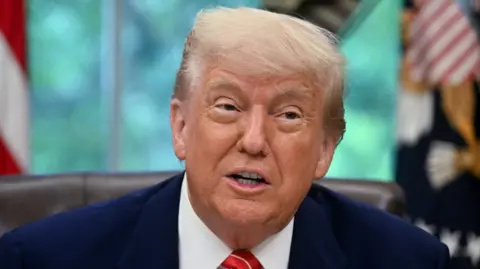**Trump Suggests Potential Tariff Reductions as US-China Talks Approach**
In a notable development in international trade relations, U.S. President Donald Trump suggested that tariffs on Chinese goods might decrease as high-ranking trade officials from the United States and China prepare to engage in negotiations. This statement comes at a pivotal moment as tensions surrounding trade policies have fluctuated significantly, impacting economies globally. Trump’s assertion indicates a shift in the longstanding trade conflict, potentially signaling a thaw in relations between the two largest economies.
Trump expressed optimism during a recent event where he announced a tariffs agreement with the United Kingdom, marking the first such deal since he imposed sweeping tariffs across various nations in April. He remarked, “You can’t get any higher. It’s at 145, so we know it’s coming down,” referring to the steep import tariffs that have reached levels as high as 145% on Chinese goods since his return to the Oval Office. The context of these tariffs includes an intensive trade war that has had wide-ranging repercussions on financial markets and global economic stability.
The scheduled meeting in Switzerland this weekend is being viewed as a crucial opportunity for both parties to deescalate the economic tensions that have been a hallmark of trade relations since Trump took office. “I think it’s a very friendly meeting. They look forward to doing it in an elegant way,” Trump stated, looking ahead to the discussions with Chinese officials. His comments reflect an eagerness for productive dialogues, which contrasts the adversarial rhetoric previously seen.
China, too, has approached the upcoming talks with confidence. Chinese Vice Foreign Minister Hua Chunying publicly conveyed that Beijing holds “full confidence” in its ability to navigate the complexities of trade with the U.S. This cooperative tone aligns with analysts’ assessments that these negotiations might foster a more constructive atmosphere, rather than exacerbating existing frictions. However, it is essential to note that while the announcement of the talks has been well-received, experts caution that resolving the underlying systemic issues will likely be a protracted process.
Former U.S. trade negotiator Stephen Olson, for example, warned, “The systemic frictions between the U.S. and China will not be resolved any time soon.” He noted that any potential decreases in tariffs stemming from the summit might be minor and should not be interpreted as an end to the broader conflicts. As discussions progress, the initial talks will be spearheaded by prominent officials, including U.S. Treasury Secretary Scott Bessent and China’s Vice Premier He Lifeng, who oversees economic affairs.
The implications of these negotiations extend beyond just tariffs. Trade experts have highlighted that significant challenges remain even if the current trade barriers were to be lifted. Eswar Prasad, a former head of the International Monetary Fund’s China division, remarked that the best possible outcome might be a moderation of the incredibly high bilateral tariffs while leaving numerous other restrictions intact.
The urgency for formalized agreements is underscored by recent data showing a drop of over 20% in China’s exports to the U.S. compared to the previous year, juxtaposed with an overall rise in China’s global exports. This disparity highlights the critical nature of stabilizing trade relations, not just for the U.S. and China, but for the broader international economy.
As global partners navigate complex trade negotiations, countries worldwide are strategizing to secure favorable terms with the U.S. before further tariffs are imposed. The Trump administration’s approach to tariffs, characterized as “reciprocal tariffs,” received attention earlier this year and thrust pressures on various nations to reach negotiations prior to the impending deadlines.
On the whole, Trump’s discussions about possible tariff reductions signal a potential shift in strategy. How the upcoming talks unfold will not only determine the course of U.S.-China relations but also significantly affect global trade dynamics in the approaching months. Stakeholders across various sectors are keenly observing these proceedings, anticipating their far-reaching effects on international commerce and economic policies.



